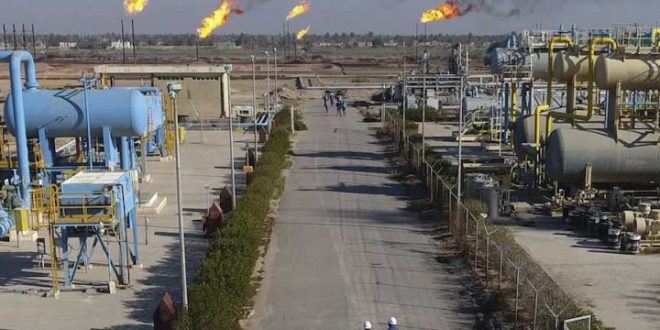Recent news reports were replete with Iraq declaring its willingness to invest $15 billion into new gas-focused projects that could reduce its reliance on one of Baghdad’s long-standing problems, its gas imports.
Baghdad has committed to an ambitious timeline of reaching self-sufficiency by 2024-2025, with several large-scale projects being developed simultaneously. The announced gas-boosting drive will encompass Total spearheading the revived $7 billion Common Seawater Supply Project (injecting desalinated water into Basrah fields and processing the freed-up gas), Sinopec developing the 4.5 TCf Mansuriyah gas field and another, yet unnamed, investor taking up the 5.6 TCf Akkas gas field. Concurrently to Iraq pushing forward with domestic gas production, Baghdad has also announced that it intends to revisit a long-forgotten pipeline project.
Iraq’s oil minister Ihsan Abdul Jabbar claimed that there is an “imminent agreement” to import Syrian gas into Iraq on April 29. Later it was specified that all the natural gas would not originate in Syria rather would transit the country all the way from Egypt. The actual volumes of the prospective imports were not specified. One striking thing about Baghdad and Damascus discussing gas pipelines is that Egyptian representatives, or representatives of companies producing gas in Egypt’s Mediterranean offshore, were absent. Thus, the end buyer was synchronizing watches with a transit nation, whilst the seller of the gas (if there ever was one) remained in the shadows. Overcoming the plethora of challenges that the Egypt-Syria-Iraq gas pipeline would create necessitates exceptional diplomatic talent, pitting Baghdad against Tehran and Washington at the same time.
Iraq has tried to play it smooth, sending its Energy Minister Majid Mahdi Hantoush to Tehran 3 days following the announcement. Mr. Hantoush stated that Iraq will continue buy Iranian gas and electricity, also vowing to pay back Iraqi debts vis-à-vis Tehran. In a rather skilful diplomatic tour de force, Iran intends to use debts generated by Iraq throughout these years as hard currency to pay for Russia’s Sputnik-V vaccine. In case of non-payment, this might mean that Moscow has agreed to take over Iraqi debt (i.e. more than $6 billion). Moscow might come out a double winner from a seemingly innocuous Middle Eastern arrears story – in Iran it would secure an outlet for its COVID vaccines, all the while its taking over such a hefty debt would inevitably be used against the federal government in trying to eke out a lucrative license deal or the acquisition of further oil and gas infrastructure.
Ensuring that Egyptian gas does indeed reach Iraq will face several immediate obstacles. The first is an all-pervasive feeling that reviving an old bungled project requires a bit more than just political backing. Back in 2004 the governments of Egypt, Jordan, Syria and Lebanon have agreed to let Baghdad into the Arab Gas Pipeline (AGP) grid, with the presumed idea that Iraq would export its gas towards Europe at some point. The 10 BCm per year capacity Arab Gas Pipeline circumflexes Israel, only to run along the Syrian-Lebanese border all the way up to the city of Homs. Since the onset of the Syrian Civil War in 2011 AGP was essentially used to iron out grid imbalances between Jordan and Egypt – when Egypt was suffering from declining production rates it imported LNG via Aqaba, when Zohr started to ramp up output the flows reversed again, and Jordan found itself importing Egyptian gas again.
Effectively this means that the Syrian section of the Arab Gas Pipeline has been unused for at least a decade, not to mention the immense destruction brought about by sabotage attacks and aerial bombardment over the course of the conflict. Debilitated economically and still unable to command the entire territory of what used to be Syria, the Syrian regime has no available funds to dispense freely, raising the question of who would repair the pipeline up until Homs and build the subsequent section towards the Iraqi border. Neither Egypt let alone Iraq can afford to spend hundreds of million of dollars on a gas conduit that would run through grey zones that might fall prey to Islamist attacks anytime. As unrealistic as the Egypt-Syria-Iraq pipeline might seem, its resuscitation serves a useful, albeit short-term, purpose.
Iraq has been asking for waivers to continue importing Iranian gas and electricity for more than 2 years and although the US State Department has so far always agreed to extend it, both sides showed signs of fatigue, having to go through the same burdensome process every 45/90 days (the latest waiver was magnanimously granted for a period of 120 days on March 31). By promoting the idea of bringing in Egyptian gas imports, it has proof of its attempting to wean off Iranian electricity. The implication of Syria renders the Egypt-Syria-Iraq pipeline even more difficult to realize as most Western backers of Iraq would prefer to avoid infrastructure projects that would directly enrich the Asad administration. Moreover, with most of Syria’s political elite under US sanctions, any pipeline transiting the country would most probably require a sanctions waiver, a step that no US President would be remarkably reluctant to take.

 Iran Energy News Oil, Gas, Petrochemical and Energy Field Specialized Channel
Iran Energy News Oil, Gas, Petrochemical and Energy Field Specialized Channel



